This summer Sarita guided a group of meditators on a sacred tour in the Himalayas, with adventures ‘in’ and ‘out’. In Part 1 we follow the group on excursions around Leh, the capital of Ladakh
High in the mountains of northern India near the Tibetan plateau, Ladakh has long been a sanctuary for monks, mystics, and lineages of enlightenment. With 17 participants from 13 countries, Sarita’s group gathered in places where masters once sat to encounter the illumined aspects of themselves.
What follows is a glimpse into this 16-day meditation journey through Ladakh, one of the most spiritually resonant regions on Earth.
Arrival in Leh
Thursday, 10 July 2025
By the time we reached Ladakh, on the auspicious day of Guru Purnima, the first priority was rest. At this altitude, nearly 3,500 meters above sea level, the body has no choice but to slow down. Headaches, nausea, dizziness, fatigue, every participant felt it to some degree. It’s a rite of passage here. The mountains demand presence, and the only way to meet them is by surrendering the usual momentum.
The first day was about letting everyone acclimatise. Our guide, Rahi, held the space beautifully. His experience with mountain terrain was obvious in the way he managed the group. He was steady, relaxed, and responsive to each person’s needs. He handled everything with such quiet confidence that the group naturally settled into trust.
My role is to facilitate meditation at sacred sites. Over the coming days, we will be sitting in monasteries where centuries of prayer have soaked into the walls, and entering caves where enlightened beings have lived and meditated.
It was heart-warming to see how quickly people softened into one another, offering support and encouragement as they moved through the initial discomfort. We also have Danelle with us, my incredible behind-the-scenes support who usually works on newsletters and web optimisation, but on this trip, stepped into a further role. She came to document the journey, and is filming and interviewing participants for what will become a travel video and written diary of our pilgrimage. For those who couldn’t join us, she is helping give voice and form to the moments that would be difficult to explain in words alone. I will be contributing to the record of this experience also, through writing and through video sharings.
On the first night I gave a discourse to the participants of our tour and it basically came through as a channelling. I was completely off my head with both jet lag and altitude effects, and yet somehow managed to invite everyone into a divine communion with the energy of Ladakh. I invited them to embrace the quality of awe, and if tears want to flow in awe at the grandeur and beauty of the landscape or during experiences of meditation in the sacred places we will be visiting, to allow those tears to flow, and that this is a returning, a homecoming for the soul. Therefore, both heart and soul will be touched, and that transformation is inevitable.
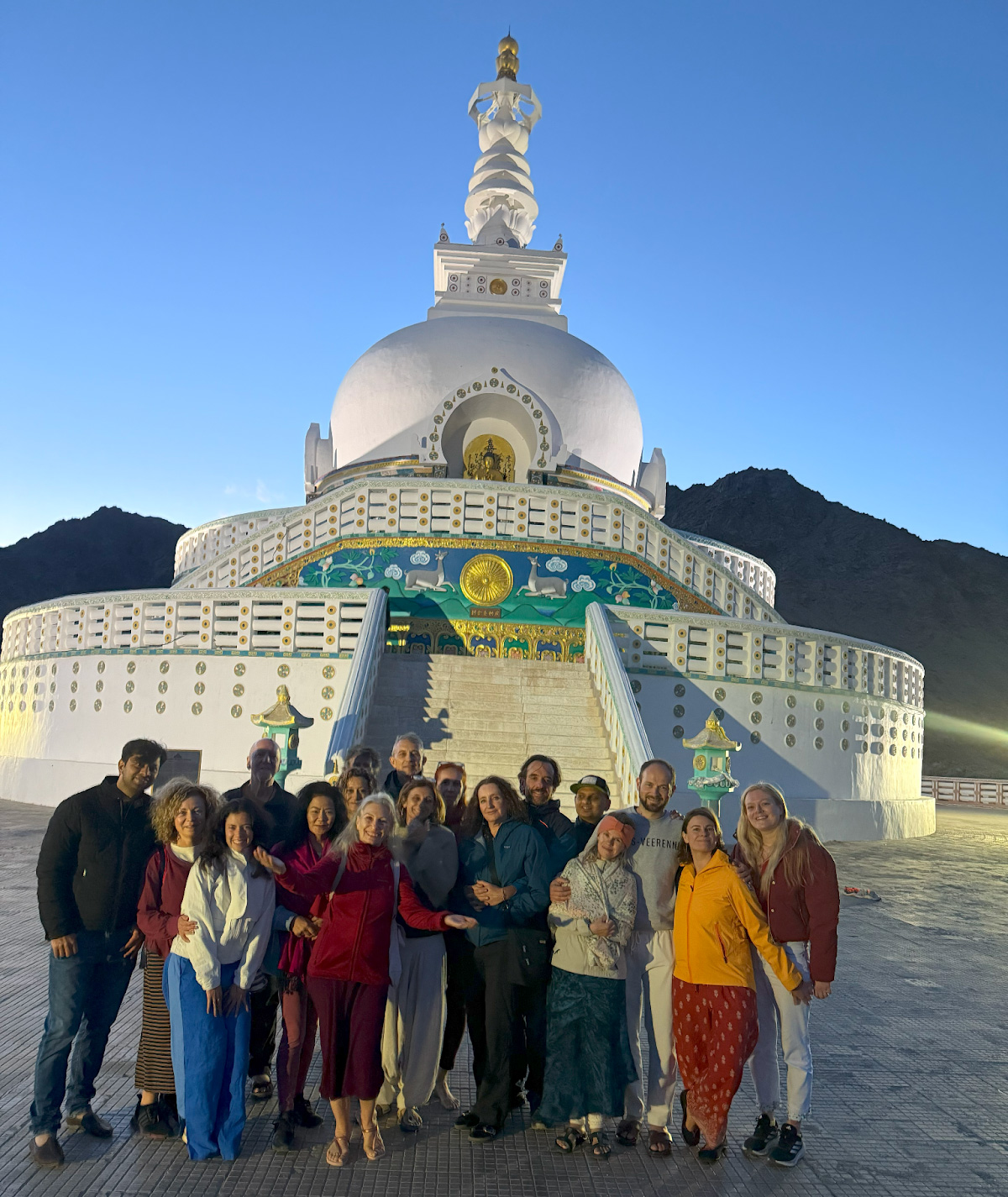
Visiting
· Shanti Stupa in Leh
Friday, 11 July 2025
On the second day, at 6pm we went to visit the Shanti Stupa in Leh.
This was created by a Japanese Buddhist monk in collaboration with Tibetan Buddhists of Ladakh. It contains at its core a relic from Gautama Buddha which infuses this special place with divine energy. It was built specially to be a beacon for world peace. Of course, for peace to become possible, each unique individual needs to work on themselves to the point where they discover Inner Peace. Who we are within is what creates the outer reality.
The stupa is a marvellous architectural wonder, built on a hill overlooking Leh and the surrounding mountains. We walked up 500 steps to reach to the top.
The place was swarming with tourists, but we managed to find a quiet space where we could practise a Meditation from the Vigyan Bhairav Tantra devoted to inner peace.
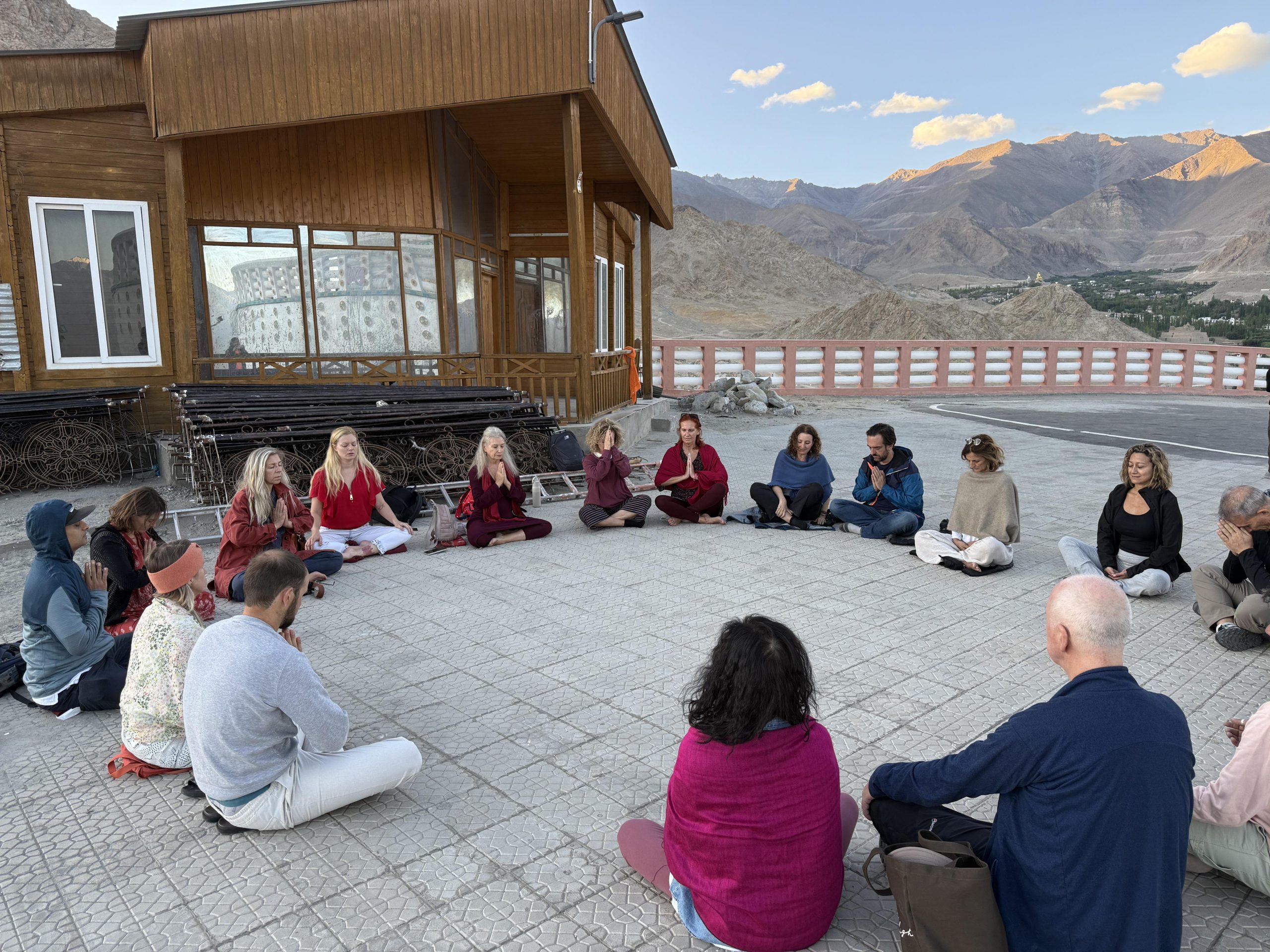
Osho News is publishing Sarita’s guiding words under their Meditation section, as it might inspire others to follow the meditation that way.
Visiting
· Thiksay Monastery
· Maitreya Buddha statue
Saturday, 12 July 2025
In the morning, still in our hotel, we practised Osho’s Mahamudra Meditation, in honour of the Thiksey Monastery which we were going to visit that day. There the monks have been practising their form of Mahamudra Meditation for hundreds of years.
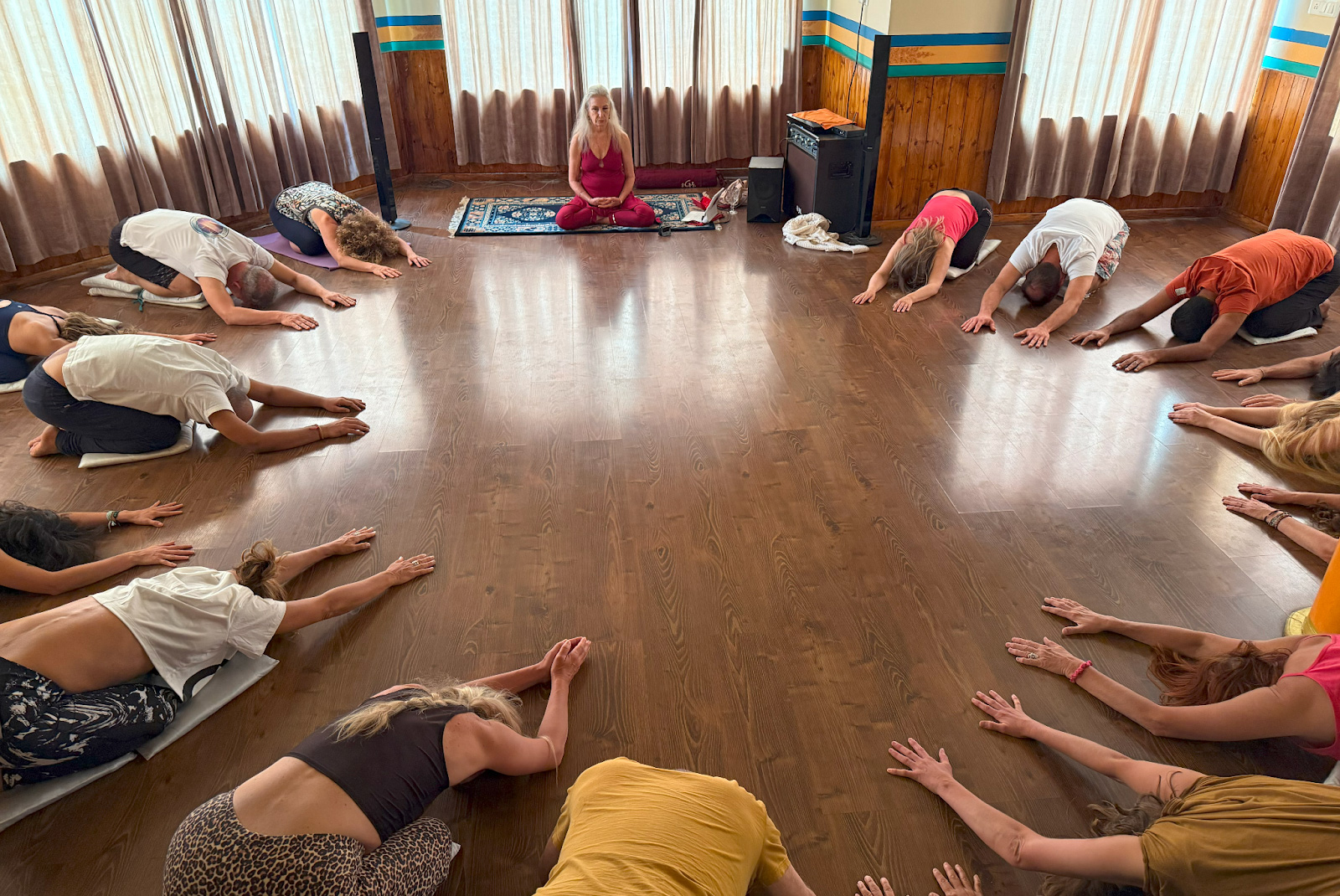
After lunch, we journeyed to the Thiksay Monastery, considered the crown jewel of central Ladakh and one of the most architecturally stunning monasteries in all of the Himalayas. Belonging to the Gelugpa tradition, the so-called “Yellow Hat” sect of Tibetan Buddhism founded by Je Tsongkhapa in the 14th century, Thiksey is a microcosm of Tibetan monastic life. Its sheer size and dramatic placement on a hilltop make it look like a cascading fortress of devotion, often compared to the Potala Palace in Lhasa, once the seat of the Dalai Lama.
From a distance, the monastery looks almost like a village within itself, stacked tier upon tier with red, white, and ochre buildings. At 12 stories high and sprawling across the hillside, it is the largest monastery in central Ladakh, and houses nearly 120 monks. Its very existence is an engineering marvel, being built in the mid-1500s, long before modern machinery or roads reached this remote high-altitude region. It still stands resilient at 3,600 meters (11,800 ft) above sea level.

The Great Maitreya Buddha
One of the monastery’s greatest treasures is the 15-meter-tall statue of Maitreya, the largest indoor statue in Ladakh, built in 1970 to commemorate the visit of the 14th Dalai Lama. The project took four years and the labour of many local artisans who cast the statue in clay and covered it with gold paint. The Maitreya is seated in the lotus posture, his gaze is soft, yet commanding, occupying a two-story chamber that radiates an aura of calm majesty.
Maitreya, whose name means “The Friend,” is revered as the Buddha-to-come, prophesied by Gautama Buddha 2,500 years ago. According to Buddhist cosmology, every 2,500 years marks a turning of the wheel of Dharma, a new spiritual era. In Buddhist thought, Maitreya’s age is the one we are entering, a time where spirituality will move from hierarchy and exclusivity toward friendship and collective awakening.
Jampa, the monk who guided us, explained that Maitreya symbolises a world where every encounter, whether with a teacher, a stranger, or even a moment of adversity, is understood as a meeting with “the friend,” a source of insight and transformation.

The founding legend
Monk Jampa shared the monastery’s origin story, rich with symbolism and the supernatural. In the 15th century, the revered teacher Sherab Zangpo, a disciple of Je Tsongkhapa himself, was instructed to establish a monastery in Ladakh to spread the Gelug teachings. His disciple, Palden Zangpo, carried out the mission. With the King of Ladakh’s patronage, he performed a ritual offering (torma) on the designated hill. But in a twist of fate, two crows swooped down, lifted the ritual cake, and carried it to another hill, where they placed it intact on a flat rock. The precision of the offering, undisturbed, was read as a message from the guardian deities.

The crows themselves are deeply symbolic in Tibetan iconography; they are seen as manifestations of Mahakala, a powerful protector deity, often invoked to remove obstacles to spiritual practice. By following the crows’ guidance, Palden Zangpo secured the monastery’s divine location. The word ‘Thiksey’ means ‘in perfect order’, commemorating how the ritual cake was found perfectly arranged by unseen hands.
Thiksay Monastery’s architectural and cultural riches
Wandering through Thiksay feels like moving through a living museum of Tibetan culture. The monastery houses ten temples, assembly halls, a library of scriptures, stupas, and a nunnery. Its paintings, or thangkas, depict Buddhas, bodhisattvas, and fierce protector deities. In the Tara Temple, devotees honour the 21 Taras, the female embodiments of compassion, each offering a unique form of aid, from protecting travellers to overcoming fear.
In one chamber sits a statue of Cham-Sung, the protector deity of Thiksay, whose role is to safeguard the teachings and practitioners of the monastery. Another chamber contains relics and images of Tsongkhapa, the founder of the Gelugpa school. The library preserves ancient Buddhist scriptures written in Tibetan and Sanskrit, many painstakingly hand-copied and preserved.
The monastery is also home to the annual Gustor Festival, held in October or November, where monks perform sacred cham dances wearing elaborate masks. These dances enact the triumph of good over evil and are believed to cleanse the land of obstacles for the coming year. Visitors from across Ladakh and beyond gather to witness the ritual, making Thiksay a community focal point.
Tibetan Buddhist training and practices
Jampa shared with us the rigours of monastic training. Novices begin not with complex meditations but with a deceptively simple discipline of carrying a bowl of water without spilling a drop from morning until night. He himself undertook this training for three years before being allowed to practise Vipassana. The exercise, he explained, develops skills foundational to meditation.
Beyond this, monks are trained in Mahamudra, the meditation on supreme emptiness. Jampa described how only after years of water-bowl practice, Vipassana and advanced visualisations, the monks are initiated into Mahamudra. At its highest levels, the practice leads to mastery of both waking and sleeping states, so profound that a monk may remain fully alert even in dreamless sleep. The ultimate fruit, according to the lineage, is attainment of the Rainbow Body, where the physical body dissolves into light at the time of death, transcending the cycle of birth and rebirth.
In preparation of the coming day, that evening, over dinner, we watched a documentary exploring the so-called “lost years of Jesus,” which spoke of his sojourns in India and Tibet. The narrative referenced manuscripts said to be kept at Hemis Monastery, a short distance from Thiksey, detailing Issa’s (Jesus’) travels, encounters with yogis, and studies of Eastern traditions. Whether legend or fact, the story highlighted what Ladakh has long been a place where spiritual currents from across the world meet and intermingle.
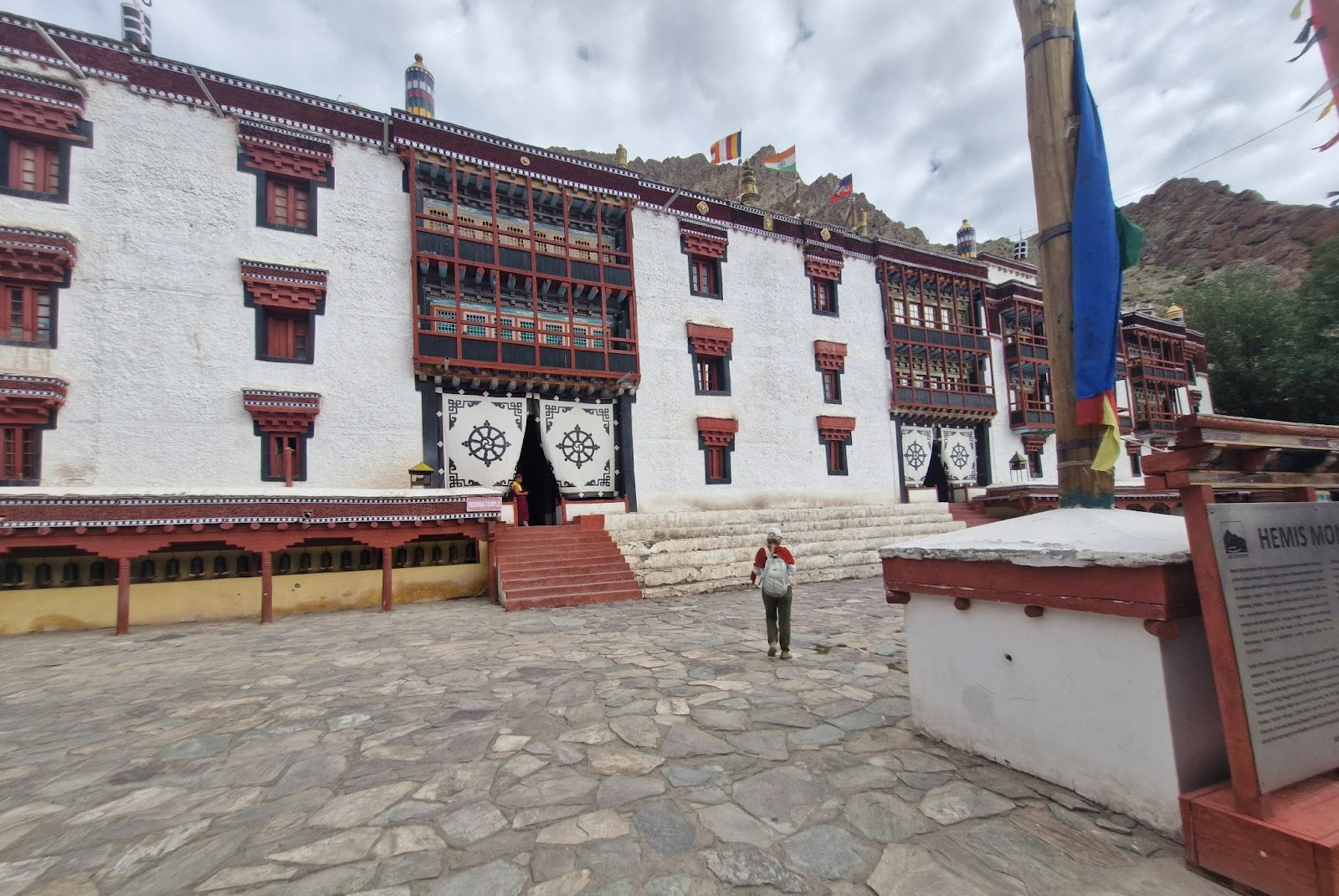
Visit to the
· Hemis Monastery
· Gotsang Gompa
Sunday, 13 July 2025
We left the hotel at 6:30am to travel for one hour to the famed Hemis Monastery, one of Ladakh’s most important spiritual sites. Though today it belongs to the Drukpa lineage of Tibetan Buddhism, Hemis is believed to have existed before the 11th century, with oral traditions tracing its origins back even further. The monastery rose to prominence in the 17th century under King Sengge Namgyal, who granted it royal patronage. Since then, it has remained a vibrant centre of Vajrayana practice, renowned for its annual Hemis Festival, where masked cham dances honour Padmasambhava.
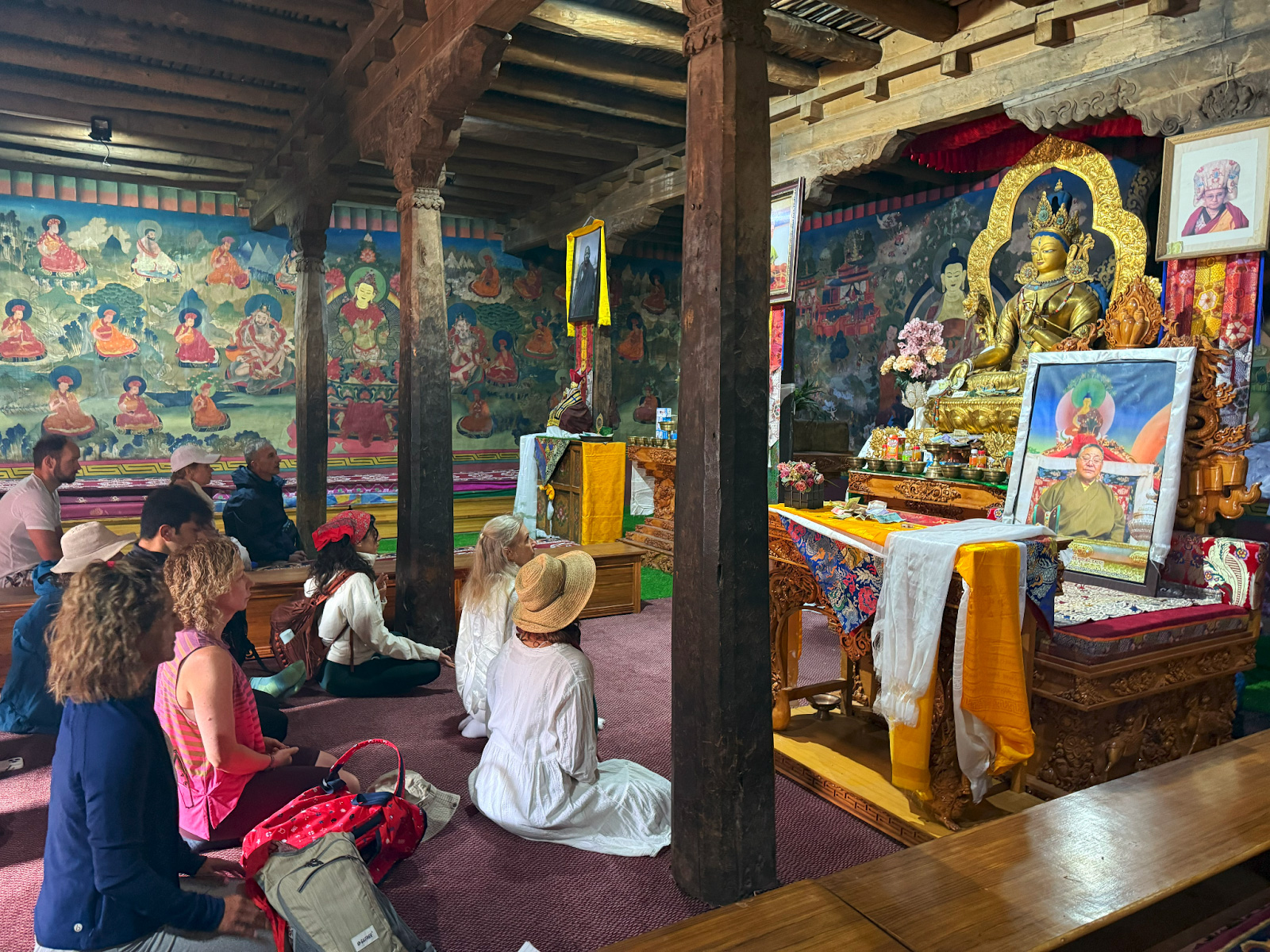
Upon arrival, we were greeted by a monk who invited us to sit and meditate in the Tara Temple, a sanctuary dedicated to the 21 Taras, each embodying an aspect of compassionate action. The air in the temple felt soft, luminous, as though centuries of prayer and mantra had soaked into the very stones.
This meditation was our preparation for what lay ahead: a 1½-hour trek up the mountain behind Hemis, to an even more ancient monastery site.
The trek to the ancient hermitage, Gotsang Gompa
The path was steep and the altitude demanding, but every step was filled with awe. Along the way, we passed mani walls, stone structures engraved with mantras like Om Mani Padme Hum, and prayer flags fluttering wildly in the high mountain winds, sending blessings across the valley below. The trail wound upward to a cliffside hermitage said to have sheltered great saints, and, as legend tells, even Jesus during his so-called “lost years.”

The hermitage is built around a cave sanctified by centuries of meditation. From the terrace outside, we looked down on sweeping valleys, snow-dusted ridges, and the Indus River threading its way like a silver ribbon far below. Here, amidst the silence and stark beauty, it is easy to believe this place could hold the memory of a wandering sage seeking truth.
We sat in a circle on the terrace to share our simple picnic breakfast, poha, fresh fruit, and warm tea – generously prepared by our hotel staff. At this altitude, even humble food takes on a sacred quality. Every bite felt grounding, nourishing, earned through the climb.
The words of Jesus
After our meal, I read aloud a passage from Prayers of the Cosmos by Neil Douglas-Klotz, which offers translations of Jesus’ words directly from Aramaic, his native tongue. Douglas-Klotz emphasises that many of Jesus’ sayings were altered when first rendered into Greek, then Latin, and finally into English. In that long chain of translation, subtle layers of meaning, especially those connected to breath, sound, and embodied spirituality, were lost.
The passage we read, a translation of the opening lines of the Lord’s Prayer, recast Jesus’ invocation in poetic, cosmic imagery:
O Birther! Father-Mother of the cosmos. You create all that moves in light. O Thou! The breathing life of all. Creator of the shimmering sound that touches us.
“Respiration of all worlds. We hear you breathing in and out in silence. Source of Sound; in the roar and the whisper. In the breeze and the whirlwind, we hear your name. Radiant one; you shine within us. Outside us, even darkness shines, when we remember.
“Name of names, our small identity unravels in you; you give it back. As a lesson, wordless action, silent potency where ears and eyes awaken, there Heaven comes. O Birther! Father-Mother of the Cosmos!”
– Jesus, from the book, Prayers of the Cosmos
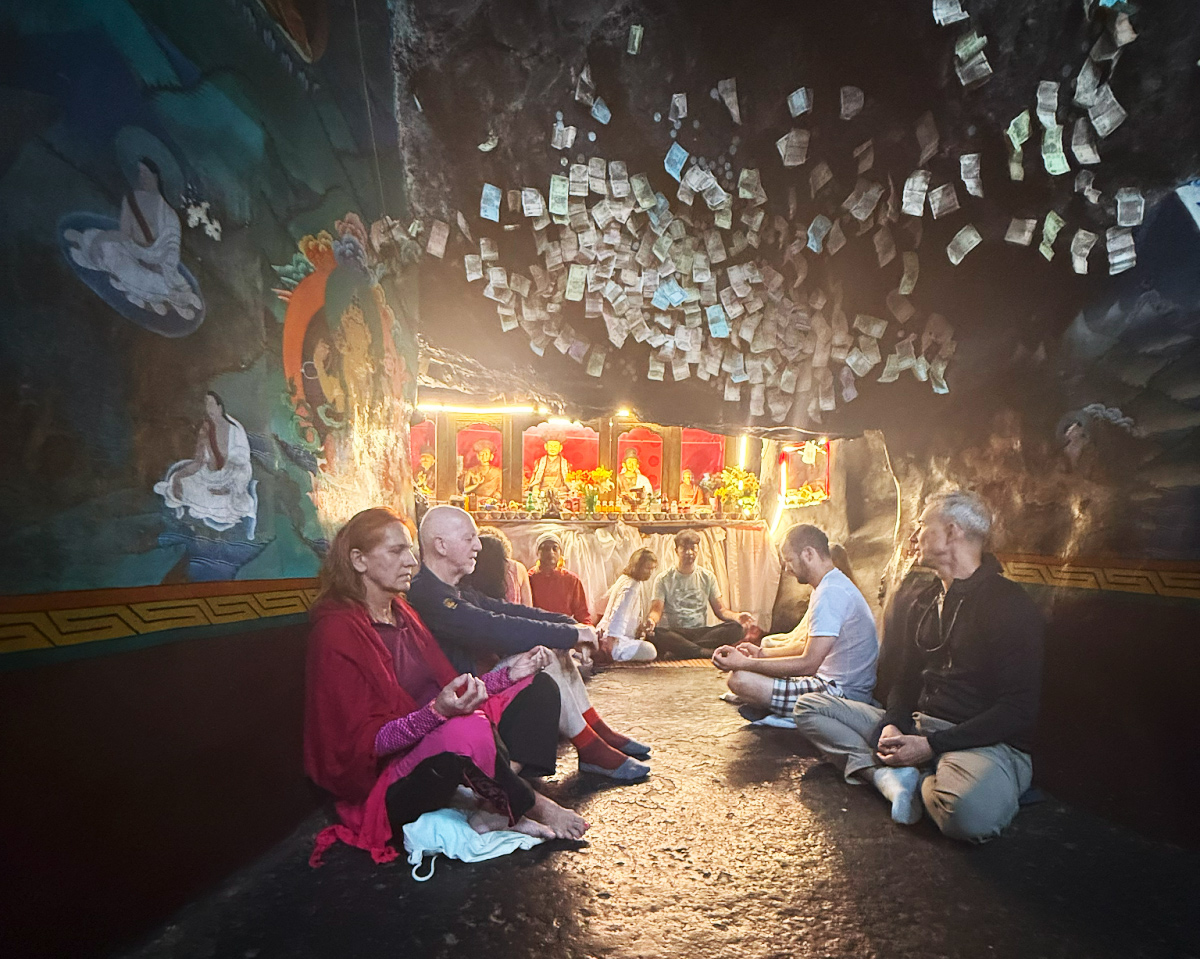
Meditation in the cave
Afterwards, we entered the cave itself. Its walls, darkened by centuries of butter lamps, carried an almost tangible vibration. Sitting in silence for an hour, each of us found our breath deepening, our minds softening into stillness. The cave felt like a womb of stone, at once grounding and elevating. For many, it was a homecoming, a place that reminded us of something ancient within ourselves.
Sites like these are often called “power spots” in Himalayan traditions, places where the earth’s energies converge and amplify spiritual practice. In Tibetan Buddhism, caves such as these are revered as places where Milarepa, Naropa and Padmasambhava once meditated, achieving visions and insights that carried into their teachings. The fact that this cave, too, is linked to Jesus in the legends surrounding Ladakh makes it a crossroads of traditions, a site where East and West meet in shared reverence for the sacred.
Honouring Padmasambhava at Hemis
Descending the mountain, we returned to Hemis Monastery proper, dedicated above all to Padmasambhava, the great tantric master who carried Buddhism into Tibet in the 8th century. Known as the “Second Buddha,” Padmasambhava is said to have subdued the local spirits of Tibet, transforming them into protectors of the Dharma.
The monastery courtyard is vast, encircled by painted colonnades. Here, every summer, monks perform the Hemis Festival Cham dances, wearing elaborately carved masks representing deities, demons, and animals. The dances re-enact the triumph of wisdom over ignorance, of compassionate action over harmful forces, in a vivid theatre of sound, colour, and movement. The festival also commemorates Naropa, one of the great Indian mahasiddhas, whose relics are said to be housed at Hemis. Naropa was the teacher of Marpa, who in turn trained Milarepa, the poet-saint of Tibet. In this way, Hemis is a living link to the transmission lineages that shaped Tibetan Buddhism.
The monastery itself houses rare treasures: ancient thangkas, scriptures, and relics, some displayed only during special festivals. Among them is the famous thangka of Padmasambhava, unfurled once every 12 years during the Hemis Festival, so large it covers the entire side of a building.
After such a profound morning, we returned for a late lunch and then welcomed a stretch of free time. Some chose to rest, while others wandered into the local market.
To be continued…
Photographs by Rahi, Danelle and participants




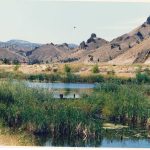
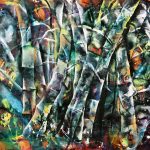
Comments are closed.